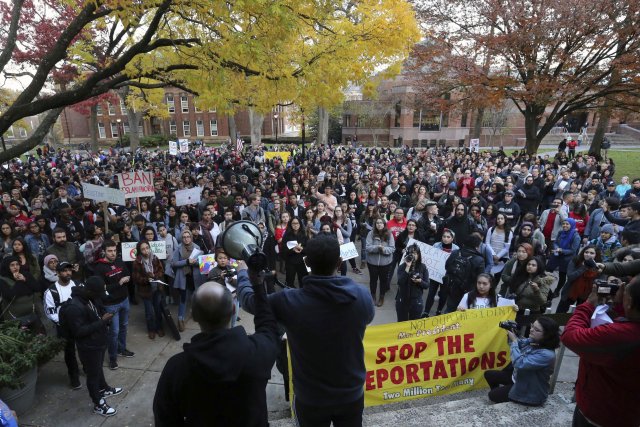
This year marks 25 years of resistance to the escalating human rights abuses of Australia’s mandatory detention laws. A whole generation has now lived under this policy and are constantly exploring new and inspiring ways of rejecting it.
One area that has not been explored, at least in recent years, and that offers a lot of potential is campaigning for university campuses to become organising spaces, welcome zones and sanctuaries.
Inspiration can be drawn from Australia’s refugee rights movement history. Refugee rights activists, including members of Resistance, ran campaigns in 2002 to make campuses centres of refugee solidarity, sanctuary and aid.
This led to student referenda, rallies and open meetings of hundreds of students passing resolutions demanding their universities become refugee safe havens.
The strategy has been taken up as part of the resistance at US university campuses to US President Donald Trump’s attacks on immigration. Students at more than 100 universities across the US have started petitions and are holding regular protests demanding their campuses become sanctuaries.
Dozens of campuses have declared themselves “sanctuaries”, with Portland State University and Reed College being the first.
The campaign has gained momentum to the point that Republican senators and governors are proposing bills to stop federal funding to colleges that declare themselves sanctuary campuses.
There are debates about what a sanctuary campus means in practice and if it is legal. At its most basic level it means not allowing immigration agents onto campuses and withholding people’s citizenship and immigration details from authorities unless they have a court order. It can also mean offering financial, legal and emotional support to undocumented students.
Activists are campaigning to take this a step further. More than 600 students and 60 organisations at The New School in New York City signed an open letter to the university president putting forward a series of concrete steps to implement the sanctuary concept.
These include training staff in how to refuse requests by immigration agents for details on students; re-evaluating protocols for referring incidents to the police, as sometimes minor offences can lead to deportations; providing financial support and accommodation to non-citizen and international students who cannot travel home during term breaks without risking being denied entry to the US; and providing access to healthcare and legal aid to students who cannot access it due to their immigration status.
As well as offering aid and support to immigrants and undocumented students, it is also playing a crucial political role. It is reasserting the old adage that bad laws need to be broken and making a political statement of refusal to cooperate with Trump’s immigration system.
So what could a refugee sanctuary university look like in Australia today?
It could take on the role of a sanctuary as in the US. There are many people in the Australian community, including those on temporary protection visas, who do not have full citizen rights and risk deportation. The Let Them Stay campaign last year highlighted this as people around the country pledged to resist deportations to Manus Island and Nauru detention centres.
Universities could offer free education to refugees who are on visas that do not allow them to access it. This could extend to accommodation and financial support.
Universities could divest from companies such as Transfield and Wilson, that are profiting from the detention system. Law departments could offer free legal aid to refugees and asylum seekers. Campuses could hold regular events to share the voices of refugees to a broader audience including speeches, meals, film screenings, art exhibitions and more.
University campuses are a great space to promote refugee rights rallies and raise awareness. They also present us with a great opportunity to take the refugee rights campaign a step further in campaigning for them to become refugee sanctuaries and organising spaces.
In implementing this, universities would be sending a clear statement to the government of non-compliance and opposition to Australia’s cruel detention system.
Like the article? Subscribe to Green Left now! You can also like us on Facebook and follow us on Twitter.